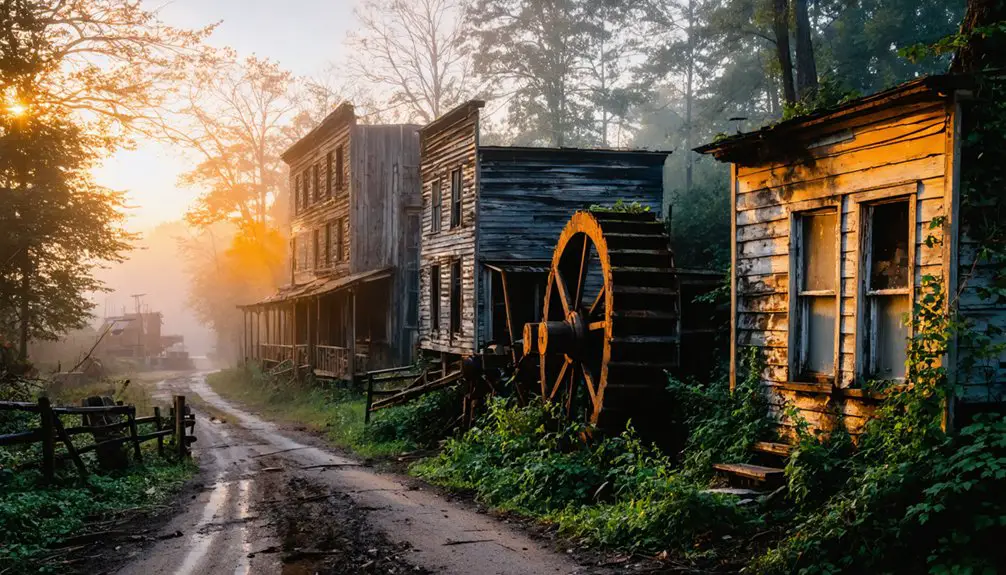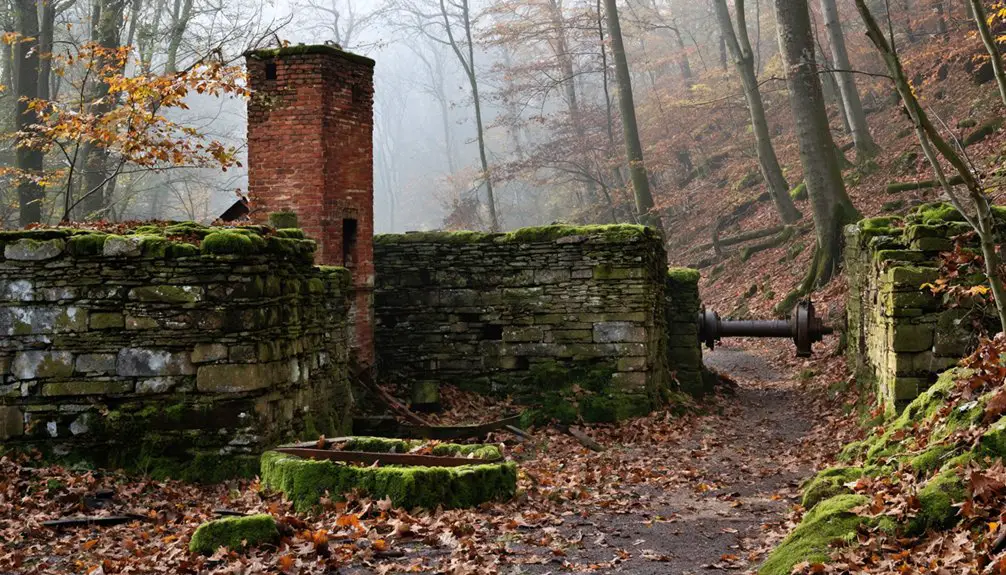You’ll find Bells Mills, a former mining town in Indiana County’s Blacklick Township, nestled in Pennsylvania’s Appalachian Rust Belt. The town flourished after its first drift mine opened in 1883, supporting a diverse immigrant community with amenities like a modern clubhouse and organized social activities. By mid-20th century, mine closures triggered mass exodus, leaving behind environmental damage and abandoned structures. Today, the historic Bells Mills Covered Bridge stands as the primary landmark, offering glimpses into the area’s industrial past.
Key Takeaways
- Bells Mills was a prosperous industrial town in Indiana County, Pennsylvania, centered around coal mining and lumber production in the 1800s.
- Edward Bell established the town as an industrial hub, owning 230 acres by 1809 and developing gristmill operations.
- The town thrived during the railroad era with repair shops employing 200 men by 1891 and peaked during World War I.
- Environmental damage from mining, including acid drainage and hazardous waste, contributed to the town’s eventual abandonment.
- Today, only the historic Bells Mills Covered Bridge remains as a preserved landmark, while the original town has largely disappeared.
Historical Origins and Coal Mining Legacy
When coal mining emerged in western Pennsylvania during the late 1700s, room-and-pillar extraction dominated the industry’s underground operations. Early miners relied heavily on manual labor methods to extract coal from these mines.
You’ll find the historical significance of Bells Mills traced to 1883, when the area’s first drift mine opened near DuBois and Falls Creek.
Mining techniques evolved as companies like Bell, Lewis & Yates established operations west and south of DuBois, including the notable Rochester Colliery. The company provided a company store for its miners and their families.
As mining expanded beyond DuBois, Bell, Lewis & Yates pioneered new extraction methods at sites like the Rochester Colliery.
The region’s mining landscape transformed further when Berwind-White Coal Company sank major shaft mines in 1893, followed by Buffalo & Susquehanna’s operations in 1904.
Rochester & Pittsburgh Coal & Iron Co. made its mark in 1891 with the Helvetia No. 1 slope mine, cementing the area’s role in Pennsylvania’s booming coal industry that fueled America’s industrial revolution.
Geographic Location and Township Details
Nestled within Indiana County’s Blacklick Township, Bells Mills stands as a tribute to western Pennsylvania’s industrial heritage.
You’ll find this ghost town in the heart of the Appalachian region’s Rust Belt, where rolling hills and creek valleys define the topographic features. The site’s position near Blacklick Creek played a significant role in its development and industrial operations. Like the Venango oil fields that transformed Pennsylvania’s landscape, this area experienced its own industrial boom and decline. The town’s population plummeted to one fifth of its original size during the industry’s decline.
The surrounding landscape reveals the area’s coal mining past, with abandoned tipples and slag deposits dotting the terrain.
While the community demographics have dwindled to virtually zero, Blacklick Township maintains its rural character through forest-covered hills and remnants of rail infrastructure.
Today, you can explore this historic area along the Ghost Town Trail, which connects former mining communities across nearly 50 miles of converted rail corridors.
Economic Rise and Industrial Development
During the early 1800s, Edward Bell’s entrepreneurial vision transformed Bells Mills into a thriving industrial hub, beginning with a gristmill and expanding into lumber production and distilling operations.
By 1809, Edward Bell had acquired 230 acres of land, establishing himself as a prominent landowner and business leader in the region.
Similar to the Rattlesnake Pike turnpike system in Antes, the area developed crucial transportation infrastructure to support its growing industries.
The economic diversification continued with the establishment of the Mary Ann Forge in 1830 and Elizabeth Furnace in 1832, creating an integrated iron plantation system.
You’ll find that a major industrial shift occurred with the arrival of the Bells Gap Railroad in 1873. This narrow-gauge line, later converted to standard gauge, connected the region to Cambria County and beyond.
The railroad’s expansion brought unprecedented growth, with repair shops employing up to 200 men by 1891. During World War I, the Bellwood Shops operated around the clock, marking the area’s peak industrial period.
Town Layout and Infrastructure
The physical layout of Bells Mills reflected its evolution from a small mill town into an industrial hub, with its grid-like pattern of streets centered around Railroad Avenue. This design made urban navigation straightforward while supporting the town’s industrial activities and residential needs. Remnants of the town can be found along the Ghost Town Trail that now spans 49.2 miles through Cambria and Indiana Counties.
As the underground mine fire spread, you’d find significant changes to the infrastructure. Similar to the success seen in Centralia’s early stages with the Locust Mountain Railroad in 1854, Route 61 required rerouting and eventual burial due to ground subsidence, while temporary roads became permanent access routes.
The town’s buildings, including the municipal office and police station, fell into disrepair as residents evacuated. Infrastructure repurposing became evident through adaptations like venting tubes to release underground pressure and the transformation of old rail lines into recreational paths, such as the Ghost Town Trail in the surrounding region.
Daily Life in the Mining Community
As European immigrants flocked to Bells Mills in the mid-19th century, they created a diverse mining community composed of Bavarians, Prussians, Scots, Irish, Welsh, Germans, French, and English settlers.
Living conditions started rough in overcrowded tent camps, but you’d eventually see proper houses and boarding facilities emerge as family dynamics evolved from single miners to settled households. A modern clubhouse provided residents with luxurious amenities like bathtubs and toilets. Many homes featured two-story wood-frame construction that characterized company-built houses of the era.
Community activities transformed from basic entertainment to organized recreation:
- Early entertainment centered on watching fistfights and informal gatherings
- Residents later enjoyed organized sports like hockey and baseball
- Theater performances became part of the social fabric
Men worked demanding shifts in the coal mines while women maintained traditional domestic roles.
As the settlement grew more permanent, you’d find an increasing number of families participating in community life, strengthening the social bonds between diverse ethnic groups.
Environmental Impact and Mining Hazards
While Bells Mills generated economic prosperity during its peak mining years, the environmental consequences proved devastating and long-lasting.
You’ll find extensive environmental degradation throughout the area, where acid mine drainage has poisoned local streams and groundwater. This toxic water threatens aquatic life and could continue impacting the ecosystem for centuries without treatment.
The town’s mining safety legacy includes dangerous abandoned mines, unstable highwalls, and hazardous waste piles that still threaten public safety today.
Contaminated soil and sediment have severely damaged stream channels, while uncontrolled erosion continues to degrade the watershed. The burning of waste coal from these mines has only compounded the environmental burden, releasing toxic emissions into the air and contributing to broader climate concerns.
The Path to Abandonment

During the mid-20th century, Bells Mills followed a trajectory common to many Pennsylvania coal towns as its mining-dependent economy crumbled. The town’s decline accelerated as mines closed and coke ovens fell silent, triggering a wave of outward migration patterns that devastated the local community spirit.
You’ll find that the town’s transformation into a ghost town wasn’t sudden but occurred through a series of cascading events:
- Essential services and businesses shut down as the population dwindled
- Infrastructure deteriorated without proper maintenance or investment
- Remaining families were forced to relocate due to lack of employment and basic amenities
The final blow came when buildings fell into disrepair, roads crumbled, and utilities failed. What was once a thriving mining community became another casualty of the Rust Belt’s industrial decline.
Present-Day Site Exploration
Today, visitors exploring the Bells Mills site will find the historic Bells Mills Covered Bridge serving as the primary landmark of this former coal mining community.
The historic Bells Mills Covered Bridge stands sentinel over its namesake site, marking where a bustling coal town once thrived.
You’ll discover this well-preserved 107-foot Burr Arch-Truss bridge spanning Little Sewickley Creek, maintained in perfect condition since its construction in 1850.
Site accessibility is straightforward via local roads near West Newton, Westmoreland County, with coordinates at 40.21917, -79.71028.
While exploring, you’ll be surrounded by scenic wooded landscapes and the peaceful creek setting that once drew filmmakers of “Bridges of Madison County.”
Though few traces of the original town remain, the natural environment offers opportunities for photography and hiking.
The bridge itself stands as a monument to 19th-century engineering, continuing to support vehicle traffic while drawing history enthusiasts year-round.
Frequently Asked Questions
Are There Any Remaining Residents Still Living in Bells Mills Today?
You’ll find current residents living along Bells Mills Road, with active property sales and occupied homes, though the area’s shifted from its town history to become a sparsely populated rural community.
What Happened to the Church and Cemetery After the Town’s Abandonment?
You’ll find the church’s last updates included asbestos roofing and concrete foundations, while the cemetery’s preservation maintained its mid-19th century headstones and access routes for continued visitation.
Were There Any Major Mining Accidents or Disasters in Bells Mills?
Despite millions of mining accidents across Pennsylvania, you’ll find no major disasters recorded at Bells Mills. Historical records show only minor incidents through 1932, reflecting better mining safety than surrounding operations.
Can Visitors Legally Explore the Bells Mills Site Without Special Permission?
You can’t legally explore this ghost town site without permission since it’s on private property. To gain legal access, you’ll need to contact landowners or join authorized historical tours.
What Valuable Artifacts Have Been Recovered From the Abandoned Town Site?
You’ll find countless mining relics like stamped ID tags, suspender clips, and railroad markers. While valuable metals are scarce, the site’s real treasures are historical artifacts revealing workers’ daily lives.
References
- https://www.islands.com/1824527/america-burning-ghost-town-once-thriving-quintessential-mining-destination-pennsylvania-centralia-fire/
- https://www.youtube.com/watch?v=8QDb8y9Nszs
- https://www.youtube.com/watch?v=NcDbPf4pkCA
- http://ironequine.com/history-bits/history-of-sidney-keal-run-lochvale-pennsylvania/
- https://en.wikipedia.org/wiki/List_of_ghost_towns_in_Pennsylvania
- https://www.pa.gov/agencies/dep/programs-and-services/mining/bureau-of-mining-programs/pa-mining-history.html
- https://duboishistory.org/history/lumber-coal-railroads/
- https://www.iup.edu/library/departments/archives/coal/coal-culture-timeline.html
- https://brewminate.com/drifts-bells-and-shafts-a-history-of-coal-mining-since-the-ancient-world/
- https://en.wikipedia.org/wiki/History_of_anthracite_coal_mining_in_Pennsylvania



